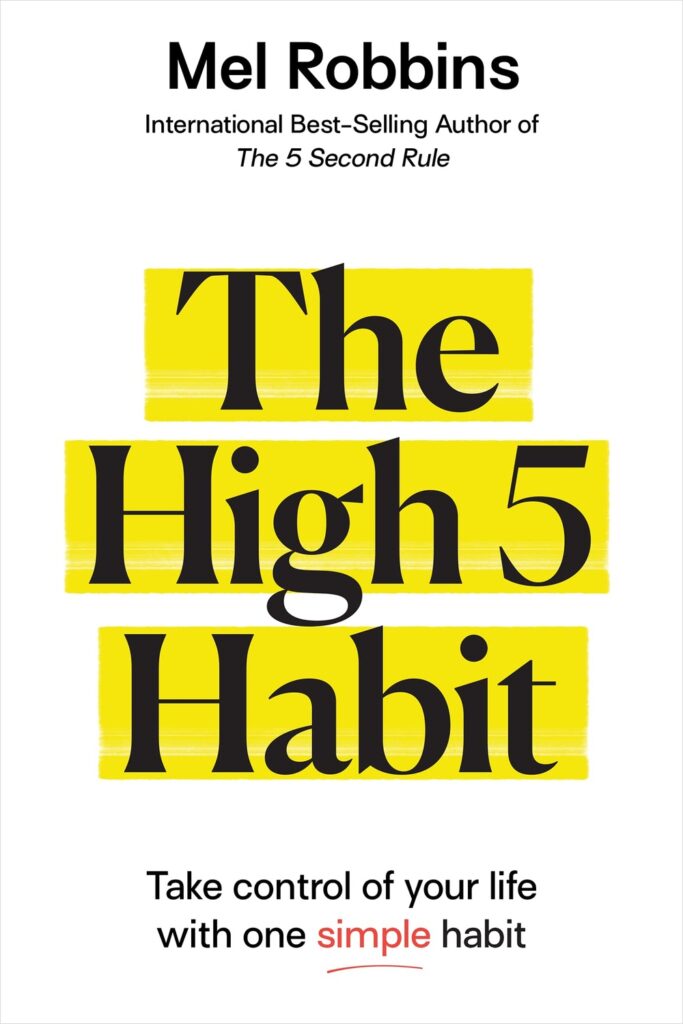Sharing my learnings from the book, The High 5 Habit by Mel Robbins
The High 5 Habit by Mel Robbins
In this book, Mel teaches you how to start high fiving the most important person in your life, the one who is staring back at you in the mirror: YOURSELF.
Using her signature science-backed wisdom, deeply personal stories, and the real-life results that The High 5 Habit is creating in people’s lives around the world (and you’ll meet a lot of them throughout this book), Mel will teach you how to make believing in yourself a habit so that you operate with the confidence that your goals and dreams demand.
The High 5 Habit is a simple yet profound tool that changes your attitude, your mindset, and your behavior. So be prepared to laugh and learn as you take steps to immediately boost your confidence, happiness, and results.

- When you stand in front of the mirror each morning, do you, like most of us, spend those morning minutes criticizing yourself and finding fault with your body?
- One morning, Robbins didn’t criticize or fret. Instead, she raised her hand toward her reflection in a kind of salute. Then she stuck it out and high-fived herself in the mirror. She was stressed and tired and dissatisfied with herself. She needed some support. But she knew the support had to come from within. In a way, the high five was a demonstration of self-belief. She made the high fives a habit, and every morning she came away from the mirror feeling a little bit better about herself.
- When you look in the mirror tomorrow morning, you’ll face a choice. You can spend the time mulling over your failings and lingering on life’s problems – or you can take a minute to congratulate and encourage yourself.
- What memories do high fives bring up for you? For Mel Robbins, one specific memory sticks out. It was 2001, and she was running the New York City marathon. She was tired, sore, and underprepared. But Robbins didn’t give up. the thing that kept her going was strangers’ encouragement – especially the high fives she received from everyone she passed along the way. That simple gesture made all the difference.
- But what about high fiving yourself – can that be as beneficial? Absolutely. According to research in a field called neurobics, high-fiving yourself can actually change your brain at a structural level. So, when you high-five yourself in the mirror, your brain understands that something novel and unfamiliar is happening; put simply, it starts paying attention. If you combine that act with thoughts of love and self-encouragement, the positive attitude becomes more likely to really stick.
- Negative thoughts can create a spiral of negative behaviors.
- messing up can make you hate yourself, and hating yourself can make you more likely to mess up. It’s a vicious circle that keeps you trapped in patterns of failure and self-loathing.
- The antidote? Being kind, supportive, and encouraging to yourself – in other words, being the type of person who high-fives her reflection.
- the mind has a filter – the Reticular Activating System, or RAS – and its job is to filter the information your brain processes, ensuring that only the most relevant data reaches the level of conscious thought. And sometimes, your RAS could also do with a thorough cleaning.
- In brief, it’s your negative and self-limiting thoughts and beliefs that’s blocking up your RAS
- Rejection, setbacks, disappointments, insults – all of these can get trapped in your RAS, leading your mind to focus on negative information while disregarding positive input
- The High Five Habit, and the patterns of self-acceptance and self-love that Robbins recommends, are the psychological equivalent of peeling away a thick layer of negativity.
- One of the criteria that your RAS uses to filter information is importance. If the RAS thinks you see negativity as relevant and significant, it’ll highlight it even more. But if you start looking out for positives, your RAS can learn to treat them as important instead.
- You’re not just at the mercy of your RAS: you can teach it what to look for, and train it bit by bit to highlight all the positives in your life.
- There are three key steps in training your RAS to see the world differently.
- interrupt your old thinking patterns. The next time you feel yourself engaging in self-criticism or feeling self-doubt, pause and say to yourself, “I’m not thinking about that.”. by refusing to rehash those same tired thoughts, you train your RAS to disregard them in the future, too.
- But it’s not enough to weaken your existing thinking patterns. You’ve got to replace them with something better – something kinder, more supportive, and more realistic.
- act like the person you want to become. You can’t change ingrained attitudes without taking action of some sort – and seeing yourself behave differently proves to your mind that your new belief is true.
- the word “sorry” seems to be constantly on our lips. if you dig a little deeper, the impulse to apologize can suggest something a little more worrying: an overactive sense of guilt that can make it hard to live a truly fulfilling life. So stop apologizing, and start saying thanks instead.
- Being exposed to gratitude feels a lot better than being exposed to guilt. In other words, it’s nicer to be thanked than apologized to.
- people who constantly say sorry can sometimes be a little bit annoying.
- People who love you want to help and support you. If they go out of their way to do something nice, don’t say sorry: show your appreciation.
- Saying thank you doesn’t just highlight the generosity of the person you’re speaking to. It also allows you to acknowledge your needs without expressing guilt about them.


Leave a Reply